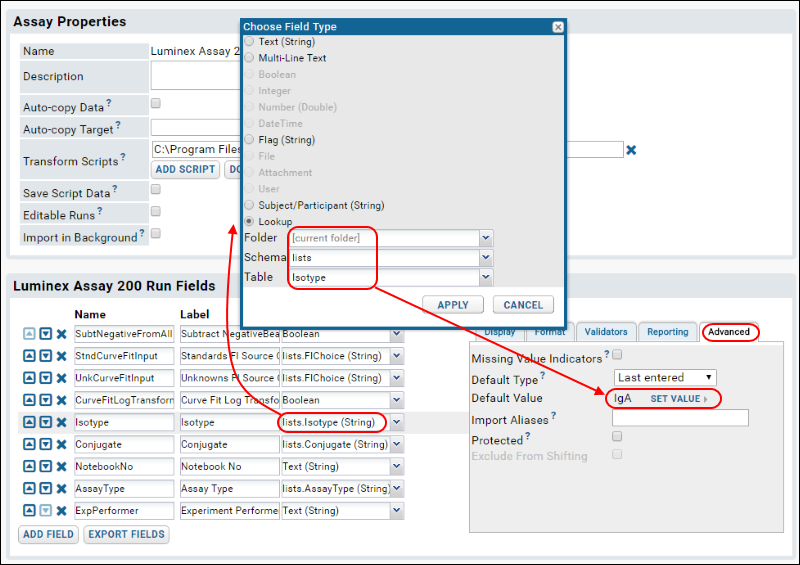This topic reviews some details and built in features of the
Luminex Assay 200 design you uploaded in archive form during
Step 1: Import Lists and Assay Archives.
Explore Lookups and Defaults in the Assay Design
Open the assay design and examine how lookups and default values are included as part of this assay design to simplify and standardize data entry:
- On the Assay Dashboard, click Luminex Assay 200
- Click Manage Assay Design > edit assay design.
- Scroll down to the Luminex Assay 200 Run Fields section.
- Click on the Type property box for Isotype to select the field and open a popup to see the type.
- To the right, click on the Advanced tab associated with the Isotype field. Note the default value of "IgA" has been set for this lookup property.

- When finished reviewing, be sure to exit with Cancel to discard any changes you may have made.
Note the following in the above screenshot:
- Lookup.
- The popup for the Type property shows that Isotype has been pre-defined as a lookup to the Isotype list (which we examined in a step above).
- User-facing result: When importing runs, users will be shown a drop-down list of options for this field, not a free-form data entry box. The options will be the values on the Isotype list.
- Default value
- On the Advanced tab, you can see that the initial Default value for the Isotype field has been set to IgA.
- User-facing result: When users first import runs, the list of drop-down options for Isotype will show a default of IgA. Choosing the default appropriately can speed data entry for the common case.
- Default Type
- On the Advanced tab, you can see that the Default type for the Isotype field has been pre-set to Last entered
- User-facing result: When users import a run, the list of drop-down options will default to the user's "last-entered" value. If the user selected "IgB" for their first run, the next will default to "IgB" instead of the original "IgA".
You can use steps similar to the ones above to explore other fields in the assay design (e.g.,
Conjugate) to see how lookups and/or defaults for these fields are pre-configured.
Review Assay Properties
While you have the assay design open, you may want to review in more detail the properties defined. See further details in
Luminex Properties. As with any assay design, an administrator may edit the default design's fields and defaults to suit the specific needs of their data and project. To do so, it is safest to make changes to a copy of the assay design if you want to still be able to use this tutorial. To copy a design:
- Choose the assay you want to copy from the Assay List.
- Select Manage Assay Design > copy assay design.
- Choose a destination folder or click Copy to Current Folder.
- Give the new copy a new name, change properties as required.
- Click Save & Close when finished.
The LabKey Luminex transform script requires certain fields to exist in the assay design in order for it to have locations to place its results. In this tutorial we make a small edit to the base design to
configure the Transform Script, but avoid making other changes or the tutorial may not work.
For further information on setting up a custom assay that includes the fields used by the transform script, see:
For further information on how to customize an assay design, see: